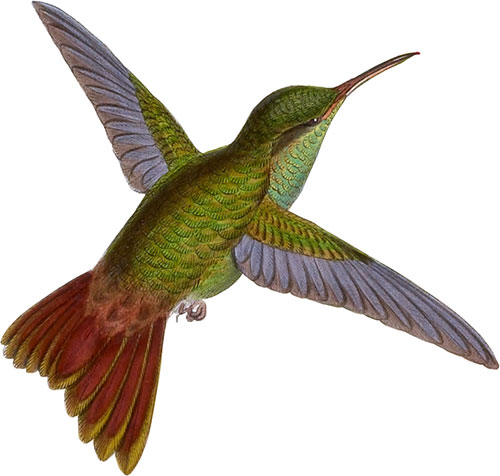I retain Dr. Cabanis’s generic term Pyrrhophæna for the ten succeeding species:—
Pyrrhophæna cinnamomea
Habitat: Central America
 Plate 307
Amazilia corallirostris
Coral-billed Amazili
Plate 307
Amazilia corallirostris
Coral-billed Amazili
“This species,” says Mr. Salvin, “seems to be an inhabitant of the hot sea-bord only, and does not extend its vertical range to a greater elevation than 2000 feet. In such regions on the Pacific coast it is very abundant, and is, in fact, the commonest of the family—in some parts almost swarming. In every village numbers may be seen flitting about the blossoms of the orange and lime trees. Its horizontal range appears to be extensive, and may be said to include the whole of the southern portion of Guatemala, from the confines of Chiapas to the State of San Salvador, and probably also embraces the Balsam Coast of that republic, as Captain Taylor obtained examples on Tigré Island in the Bay of Fonseca.”—Ibis, vol. i. p. 130.
“It is common about San Gerénimo; but seems not to be found in the colder and more elevated portions of the republic, neither occurring at Dueñas nor Coban. A nest with two young and the hen bird was brought to me Dec. 6th; the young were half-grown, and would have flown in about ten days. My specimens show that, as far as the feathers are concerned, the sexes are alike. A difference, however, exists in the bill,—that of the male having much more of the brilliant colour from which the species takes its name, in the upper mandible. In the young bird the upper mandible is black.”—Ibis, vol. ii. pp. 268, 269.
Pyrrhophæna cerviniventris (Gould)
Habitat: Mexico. In the neighbourhood of Cordova, according to M. Sallé.
 Plate 309
Amazilia cerviniventris
Fawn-breasted Amazili
Plate 309
Amazilia cerviniventris
Fawn-breasted Amazili
Pyrrhopæna castaneiventris
Habitat: New Granada
 Plate 310
Amazilia castaneiventris
Chestnut-bellied Amazili
Plate 310
Amazilia castaneiventris
Chestnut-bellied Amazili
Pyrrhophæna Riefferi
Habitat: Southern Mexico, Guatemala, and along the Andes to Ecuador
 Plate 311
Amazilia Riefferia
Rieffer’s Amazili
Plate 311
Amazilia Riefferia
Rieffer’s Amazili
Nearly thirty specimens are now before me from these various countries, among them M. Bourcier’s type specimen of his Trochilus Dubusi, also specimens collected by Warszewicz in Costa Rica; and I see nothing to induce a belief that there is any specific difference between those found in Mexico, Guayaquil in Ecuador, or in any of the intermediate countries. I admit that differences occur both in size and in the fringing of the outer tailfeathers: generally speaking, they are darker in the Costa Rican and New Granadian specimens; but I have some quite as bronzy from those countries as the generality of specimens found in Honduras and Guatemala. These latter are the birds to which the term Dubusi has been applied.
Pyrrhophæna beryllina
Habitat: Southern Mexico. M. Botta found it at Orizaba, and M. Sallé at Cordova.
 Plate 312
Amazilia beryllina
Berylline Amazili
Plate 312
Amazilia beryllina
Berylline Amazili
Pyrrhophæna Devillei
Habitat: Guatemala
 Plate 313
Amazilia Devillei
Deville’s Amazili
Plate 313
Amazilia Devillei
Deville’s Amazili
Speaking of this species, which by some inadvertence he has called A. Dumerili instead of A. Devillei, Mr. Salvin says, “During the months of July, August, and September, one of its most favourite resorts was the western boundary of the Llaño of Dueñas, which, starting from the village and bounded to the eastward by the river Guacalate, extends, sweeping by the Volcan de Fuego, almost to the Hacienda of Capertillo, its southern extremity. Dispersed all over this plain is found, in groves, patches, and isolated trees, a Tree Convolvulus, bearing a white flower, and attaining an average height of about 25 or 30 feet. During the above months this elegant species might be seen in almost every tree, some feeding among the flowers, some settled quietly on a dead branch, uttering their low, plaintive, hardly to be called musical, yet certainly cheering song, others less peacefully occupied in a war of expulsion, driving out by vehement cries and more effectual blows the tenant of a tree, which in its turn wreaks vengeance on some weaker or unexpectant antagonist.”—Ibis, vol. ii. p. 270.
Pyrrhophæna viridigaster
Habitat: New Granada. Common in the neighbourhood of Bogota.
 Plate 314
Amazilia viridigaster
Green-bellied Amazili
Plate 314
Amazilia viridigaster
Green-bellied Amazili
Pyrrhophæna iodura
Habitat: New Granada?
No illustrations
The specimen named iodura in the Museum of M. Heine at Halberstadt is different from the bird so called in the Museum at Berlin. The former has a glittering crown and light-lilac shining tail-feathers; while the latter has a dull-coloured crown, and the tail so nearly resembling that of P. viridigaster that I have no doubt of its being a young bird or a female of that species. On the other hand, I think M. Heine’s bird is a distinct species, and I have therefore retained it under the term iodura.
Pyrrhophæna cyanura
Habitat: Pacific side of Nicaragua; Realjo?
 Plate 315
Amazilia cyanura
Blue-tailed Amazili
Plate 315
Amazilia cyanura
Blue-tailed Amazili
Featuring all 422 illustrated species from John Gould’s A Monograph of the Trochilidæ, or Family of Humming-Birds arranged by color.